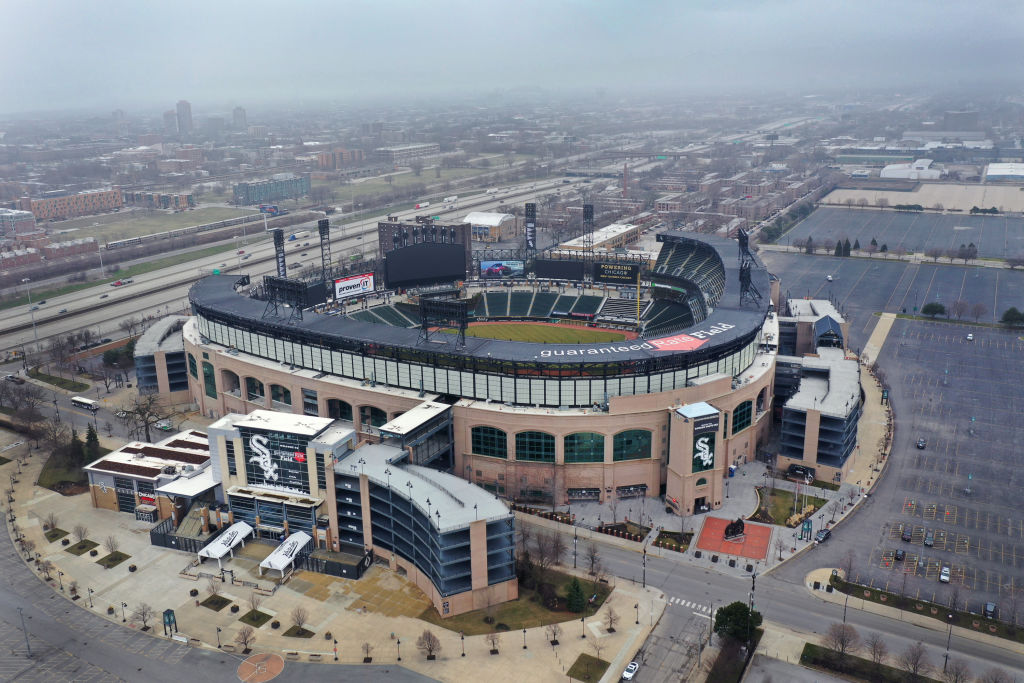Jerry Reinsdorf is many things, but as his Chicago White Sox ponder fleeing their state-subsidized stadium and fleecing Illinois taxpayers out of at least a billion dollars to build a new ballpark, I think of him first and foremost as a crappy neighbor. Reinsdorf bought the team for a cool $19 million in 1981; as of last year, the team was valued at $2.05 billion—only the 15th-most valuable MLB franchise, but still a boon to Reinsdorf, who is personally valued at $2.4 billion. Yet despite demanding a $137 million replacement for Comiskey Park in the late '80s, with an additional $118 million in repairs and redesigns implemented in the years since, the stadium’s lackluster design and lifeless surrounding environment has given Reinsdorf wiggle room to once more try to bilk public officials. In pursuit of this mission, the team has unveiled images of a bright, shiny future just a few miles north: the luxury environs of one of Chicago’s faltering new megadevelopment projects, "The 78."
This song and dance is nothing new among the ownership class. But the White Sox case study feels particularly damning, especially when the Cubs, just a 30-minute Red Line ride north, use their historic ballpark to anchor the increasingly bland but still dense and lively Wrigleyville neighborhood. The White Sox's lease at Guaranteed Rate Field is set to expire in 2029, and judging by Reinsdorf’s public comments, he cannot envision a future in which the team continues playing in Armour Square, their home since 1901. Yet given the remarkable social and economic drag made by the stadium since it opened 33 years ago, one can see misery from both sides. What if the team walks away, leaving behind an albatross of a neighborhood? Perhaps even more troublingly, what happens if the team stays and nothing changes—its fans fated to cheer for years of bad baseball in one of the most lifeless ballparks ever conceived?
For a baseball stadium that has three separate train lines within walking distance, there’s no more generic, suburban-feeling city ballpark open today than Guaranteed Rate Field. That’s by design. After Reinsdorf engineered the 11th-hour deal that kept the team in Chicago in the late '80s, their HOK-designed ballpark was rejected by the Baltimore Orioles, who quickly ushered in a new era of city-centric ballparks with Camden Yards. It’s no surprise that the current stadium design was also intended to be the team’s home if they followed through on a proposed relocation to the suburb of Addison—the stadium’s 70 acres of parking and immense design have been a white elephant ever since.

The original Comiskey Park, constructed in an era before car-centric planning reshaped the city and its surrounding populations, was nestled within the confines of a vibrant, working-class community, at the crossroads of the whiter Bridgeport to the west and the large black population living in public housing just south of the park. The current stadium kept a sense of neighborhood continuity alive, but at a cost. To build it, 178 housing units, primarily inhabited by black residents, and 12 private businesses were wiped off the map, with Comiskey Park land converted into additional parking. This meant the loss of community infrastructure vital to the team’s lore: Beloved dive bar McCuddy’s, whose owners were given a drunken promise by Governor Jim Thompson that the bar would be reconstructed after the stadium was completed, was instead destroyed for good, erasing eight decades of fan memories in the process.
For the time being, Guaranteed Rate Field is home. But the cursed vibes for this year’s campaign started before Opening Day even rolled around. More than half of the lamppost vinyl banners outside the park, usually devoted to the team's stars, were occupied by generic fans. The team’s “It’s Better At The Ballpark” slogan sounds like a cry for help from a franchise that’s been in 20th place or worse in team attendance for all but two seasons since 2011. (Not that this matters much to ownership: The team doesn’t have its box office revenues taxed unless it passes two million in attendance, a feat managed just 11 times since the new stadium opened in 1991.) The stench of decay exuding from the franchise comes from multiple sources, but it’s hard to not cast the ballpark and its surroundings as its rotting core. Still, the baseline promise of a park in the city allows one to think of Homer Simpson’s infamous ode to alcohol when imagining their home now: “To Guaranteed Rate Field, the cause of, and solution to, all White Sox fan’s problems.”
Opening Day was a glimpse into an urban ballclub at a crossroads. With attendance over 30,000, the parking lots were full or close to it, something that otherwise only really happens during the Cubs series. While tailgating near the park is a time-honored tradition for many, fans without cars could still get in on the action thanks to Bike Sox, a fan-led initiative started near the end of the 2021 season. Daniel Streicher, one of the co-founders of the group, has mostly complimentary things to say about how the team has supported their efforts—offering the group special ticket packages and additional bike parking as it began to draw more participants. Streicher says his best-case scenario for the franchise is to build a parking garage adjacent to the highway—land that nobody would want to live on anyway—and then fill in much of the existing lots of with housing and commercial development.

“[Guaranteed Rate] has all the ingredients of an incredible modern, urban ballpark: It's closer to downtown than Wrigleyville, it's surrounded by great neighborhoods, it's surrounded by transit, and a ton of people already use transit to get here,” Streicher says. “If you come in from Halsted west under the viaduct, you can almost pretend that all this isn't here, but we still have these parking lots, and that's the only thing. If they develop the parking lots, I think they’d have what they want.”
Once inside the gates and at my seat, I was almost able to forget all the drama circling the team. Sure, a lifeless 1-0 loss, carried out in just three minutes over two hours, never saw the Sox advance past first base—a harbinger of plenty more bad baseball to come. But as the team debuted a new sponsored mid-inning promotion by the Chicago Transit Authority, with two rows of fans tasked with snaking a cardboard train car from one end of a section to the other and back, it was easy to hope that the Sox could continue to lean into this citified energy, acknowledging the reality that its fans want many of the same things that draw fans to Wrigleyville: less wasted asphalt and more dense urban construction that reawakens the neighborhood as it was during eight decades of Comiskey Park play.
If the White Sox are going to recreate Wrigleyville, they should do it right where they are now. For sports economist Victor Matheson, who has done extensive research on the subsidy of stadium construction, the biggest crime possible is relocating a team within the same city limits—a financial debacle so obvious that the entire field of economics is almost uniformly in agreement.
“Unless you've got an economist who's bought and paid for by someone, that’s pretty much what the feeling is of pretty much every economist out there. If the White Sox have a better place to play and a better deal somewhere else, we should let them do that. That's what we let businesses do, right?” Matheson says. “But it doesn't make sense to spend any money simply to relocate economic activity by a few miles.”
What’s also nonsensical are the rosy economic promises made by the development firm and the team. To cite the most ridiculous example, Related Midwest claimed that a new stadium inside The 78 would draw upwards of 5 million visitors per year, or the equivalent of 60,000 attendees and hangers-on for each of 81 home games. Less noted as part of these proposals, but more salient to those of us who live adjacent to the current stadium, are the hypothetical renderings that Related Midwest offered showing many of the surrounding parking lots filled in with new housing and commercial properties that would bring a spark of life to the area. These renderings only exist because the team wants to move, and we’re not supposed to imagine the White Sox transforming the land around the current stadium. Still, to preserve the status quo—70 acres of largely wasted space, ripe and ready to be reawakened—is a proposition that only the most car-brained suburbanite could defend when a much better alternative is clearly available.
When just a few games a year fill the team’s overly generous parking to capacity, and a growing body of fans are demonstrating their eagerness to show up to the park on foot, via mass transit, or by bike, what could be accomplished if we demanded these spaces be returned to greater public use, building homes that would surely be filled by fans eager to live steps away from a baseball stadium? It will require visionary leadership to thread this needle, but now is the moment for fans and government officials to demand such a shift and call Reinsdorf’s bluff. Considering the fact that researchers in Denver found that parking lots adjacent to the Broncos' stadium resulted in just a 1.6 percent return on the land value annually—hard economic data that doesn’t even account for the myriad social and community drags that come with replacing dense urban space with dedicated asphalt that Stacey from Oak Park might use seven times a year—we need to be more honest about how badly Reinsdorf has been wasting the economic utility of his own investment.
In more ways than one, White Sox fans are fated to live in purgatory for the next few years. Reinsdorf is 88 years old and has indicated a willingness to sell the team to investors who envision a move to Nashville in the future. Whether these are empty threats or a realistic outcome at the end of the existing lease remains to be seen. Reinsdorf has been brazen enough about his cocky-businessman bullshit to brag to Cigar Aficionado magazine in the mid-'90s that “a savvy negotiator creates leverage. People had to think we were going to leave Chicago.” But if there are credulous idiots willing to be teased with drawings of a shiny new ballpark, many of us are more seduced by the image of a neighborhood ballpark no longer drowning in parking, a path the team could have undertaken decades ago but failed to pursue. It’s an outcome that hangs in the balance today—a more hopeful future that only became truly imaginable once the team began teasing yet another escape.
As I shuffled out of the stadium on Opening Day while surrounded by a sea of fans—something I’ve only experienced once before, at the end of the team’s season-ending 10-1 loss to the Astros in the 2021 ALDS—a few halfhearted chants of “Detroit sucks” flared through the crowd. Far more fervently, a round of spirited “Sell the te-am” clap-clap-clapclapclap cries pealed up and down the exit ramp, as fans with generations of affinity to the team and this turf attempted to invoke a future where the franchise was more than a leverage for a real-estate deal. Now, to save Reinsdorf from that special circle of hell for sports owners who move beloved franchises to new cities, it’s time to beat Jerry at his own game: Develop the parking lots, make the stadium the hub of economic activity he claims he wants, and preserve a legacy of South Side baseball that belongs to everyone, not just in the greasy hands of one cigar-chomping billionaire.






